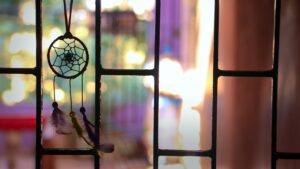Dreams, often ephemeral and enigmatic, have long captivated human imagination and sparked a myriad of interpretations across cultures. Among the many traditions aimed at understanding and harnessing the power of dreams, the dreamcatcher stands as a striking symbol of both artistic expression and spiritual significance. Rooted in Native American heritage, this intricate creation not only showcases the beauty of craftsmanship but also carries a deep connection to the realms of the subconscious. In this guide, we invite you to explore the history, symbolism, and process of crafting your own dreamcatcher.
A Glimpse into Dreamcatcher History: Unraveling the Web of Tradition
The origin of the dreamcatcher can be traced back to the Ojibwa (Chippewa) people, who inhabited the Great Lakes region of North America. Initially known as “asabikeshiinh,” which translates to “spider,” these intricate objects were traditionally woven by skilled artisans. The design was inspired by the spider’s web, a natural creation believed to capture and filter dreams. According to Ojibwa legends, the dreamcatcher would allow good dreams to pass through its centre, while bad dreams would become entangled in the web, vanishing with the first light of day.
As European colonization spread across North America, so too did the dreamcatcher, evolving and adapting to reflect different cultural beliefs. Over time, dreamcatchers also gained wider popularity, transcending their original context and becoming a symbol of unity, protection, and connection.
Unveiling the Symbolism: Dreams, Spirituality, and Protection

Beyond their aesthetic appeal, dreamcatchers hold a profound spiritual significance for many. The general belief among spiritualists is that dreamcatchers are imbued with the power to ward off negative energies, offering a shield of protection to those who possess them. They are often hung above beds or in other prominent locations, where they are believed to filter out nightmares and ensure a peaceful slumber.
In addition to their protective qualities, dreamcatchers are also seen as symbols of interconnectedness. The web’s intricate pattern reflects the interwoven threads of life, highlighting the importance of unity and harmony within both the natural and spiritual worlds. As modern society grapples with the challenges of disconnection and fragmentation, dreamcatchers continue to serve as a poignant reminder of the need for balance and interconnectedness.
Crafting Your Own Dreamcatcher: Weaving Dreams into Reality
Crafting a dreamcatcher demands cautious reflection. Rooted in Indigenous American cultures, dreamcatchers carry profound spiritual significance. As their popularity has traversed cultural boundaries, dreamcatchers have increasingly been seen as little more than beautiful decorations. When choosing to make one, it is therefore, essential to embrace the dreamcatcher’s history and maintain a respectful approach to avoid diminishing their cultural essence. Embracing the artistry while honouring origin is imperative to prevent inadvertent cultural appropriation.
Done correctly, creating a dreamcatcher is a meditative and rewarding process that allows you to not only embrace their spiritual aspect but also channel your creativity. Here’s a step-by-step guide to get you started:
Materials Needed:
- Metal or wooden hoop (traditional dreamcatchers use a willow hoop)
- Suede cord, yarn, or twine
- Feathers, beads, and other decorative elements
- Scissors
- Glue
- Needle
Instructions:

- Prepare the Hoop: Start by wrapping the hoop with a suede cord, yarn, or twine. This will serve as the base for your Dreamcatcher’s web. Secure the wrapping with a dot of glue at the beginning and end.
- Creating the Web: Tie a knot at the starting point of the hoop. Thread the cord across the hoop, looping it around the circumference to create a circular pattern. Continue this process, gradually moving inward with each loop. You can vary the pattern by adding additional loops or skipping spaces.
- Incorporate Beads and Feathers: As you weave the web, consider incorporating beads or feathers into the design. These elements not only enhance the aesthetic appeal but also carry personal significance and meaning. Attach them securely to the cord as you go along.
- Finishing Touches: Once the web is complete, tie a knot to secure the end of the cord. Trim any excess cord with scissors. Attach feathers and beads to the bottom of the dreamcatcher, symbolizing the connection between the spiritual and physical realms.
- Hang with Intent: Choose a meaningful location to hang your dreamcatcher, such as above your bed or in a space where you often reflect or meditate. As you hang your creation, set an intention for positivity, protection, and the filtering of dreams.
Crafting a dreamcatcher is not just an artistic endeavour; it’s a journey that invites you to explore history, connect with spirituality, and infuse intention into a tangible creation. As you admire your handiwork, you’ll be reminded of the threads that bind us all—dreams, hopes, and the universal desire for balance in an ever-changing world. In a society that often rushes past the ethereal realm of dreams, the dreamcatcher serves as a steadfast reminder of the power of mindfulness, unity, and the beauty that emerges when we intertwine tradition with personal expression.


